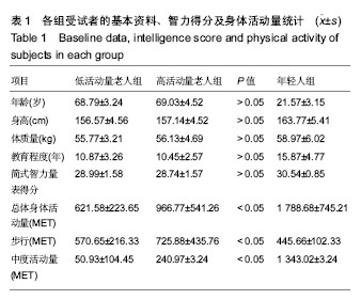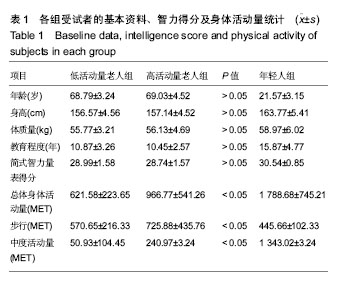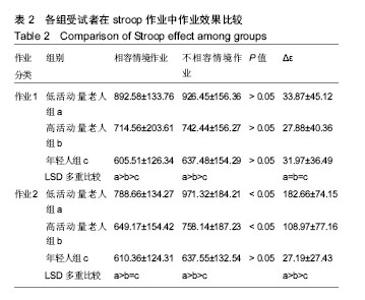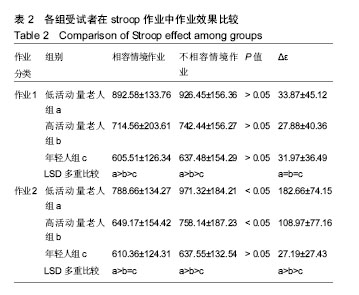Chinese Journal of Tissue Engineering Research ›› 2019, Vol. 23 ›› Issue (11): 1693-1699.doi: 10.3969/j.issn.2095-4344.1137
Previous Articles Next Articles
Influence of physical activity on executive control function in older adults by event-related potentials
Li Jintian
- (College of Physical Education, Shaoguan University, Shaoguan 512026. Guangdong Province, China)
-
Received:2018-11-21Online:2019-04-18Published:2019-04-18 -
About author:Li Jintian, Associate professor, College of Physical Education, Shaoguan University, Shaoguan 512026. Guangdong Province, China -
Supported by:the Social Science Foundation of Guangdong Province, No. GD17CTY02 (to LJT)
CLC Number:
Cite this article
Li Jintian . Influence of physical activity on executive control function in older adults by event-related potentials[J]. Chinese Journal of Tissue Engineering Research, 2019, 23(11): 1693-1699.
share this article
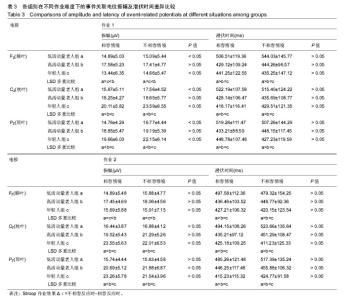
表2显示: (1)对反应时间的检验。3组受试者在2种Stroop作业及2种情境(相容及不相容情境)的反应时间,经三因素混合设计方差分析发现:不同组别因素,F=11.59,P < 0.05、不同情境因素,F= 89.77,P < 0.05,交互作用中:“作业*情境”因素,F=16.89,P < 0.05、“组别*情境”因素,F=11.55,P < 0.05及“组别*作业*情境”三因素作用,F= 8.14,P < 0.05;进一步分析显示“组别*情境”对作业一不显著,F=1.18,P > 0.05,但对作业二达到显著水平,F=17.62,P < 0.05。 (2)事后比较发现:在难度较低的作业1中,不论老年组还是年轻组,同一组别在相容与不相容情境下的反应时间皆不存在差异(P > 0.05);在难度较高的作业2中,老年2组在不相容情境下的反应时间显著高于相容情境,而年轻人组(对照组)相容与不相容情境下的反应时间无显著差异(P > 0.05)。 (3)不同组别间的LSD多重比较发现,在难度较低的作业1中,不论是相容情境还是不相容情境下,皆一致表现为低身体活动量老年组的反应时间显著高于高身体活动量老年组,而高身体活动老年组则显著高于年轻人组(对照组);在较高难度的作业2中,相容情境作业下,低身体活动量老年人组的反应时间显著高于高身体活动量老年人组(P < 0.05),但高身体活动量老年人组与年轻人组反应时间无差异(P > 0.05),不相容作业下,则表现为低身体活动量老年人组显著高于高身体活动量老年组,而高身体活动量老年人组显著高于年轻人组(P < 0.05)。 (4)Stroop作业效果?ε=不相容情境下的反应时间-相容情境下反应时间,它作为个体抗干扰控制能力的重要指标[27]。在难度较低的作业1中,3组的Stroop作业效果不存在差异(P > 0.05);在难度较大的作业2中,Stroop作业效果则一致表现为低活动量老人组>高活动量老人组>年轻人组(P < 0.05),意旨低身体活动老年人组慢于高身体活动老年人组,而高身体活动老年人组则显著慢于年轻人组。 2.4 不同组别间事件关联电位中P300潜伏时间及振幅分析 见表3。 表3显示: (1)3组受试者P300潜伏时间,经4因素方差分析显示主效应中,组别因素显著,F=5.12,P < 0.05、不同电极因素显著,F=6.05,P < 0.05,组别*电极因素二因素交互作用显著,F=3.54,P < 0.05,作业*情境*电极因素三因素交互作用显著,F=5.74,P < 0.05。 (2)经事后比较显示:同一电极下,同一组别下,不论作业难度高低,在相容及不相容情境下的潜伏时间无差异(P > 0.05);在作业1、2两种难度下,不论是相容还是不相容情境,不同组别间潜伏时间几乎表现出高度一致性,即3个电极FZ、CZ与PZ电极P300潜伏时间皆达到显著水平,且一致表现为低身体活动量老人组潜伏时间显著高于高身体活动量老人组及年轻人组,但2个老人组潜伏时间没有差异(P > 0.05)。 (3)3组受试者P300振幅,经4因素方差分析(作业类别、不同组别、不同情境、不同电极)显示:主效应中电极因素显著,F=18.15,P < 0.05,组别因素显著,F =5.19,P < 0.05,作业*情境交互效应显著,F= 3.81,P < 0.05、组别*电极交互效应显著,F=7.14,P < 0.05,组别*作业交互效应显著,F= 3.48,P < 0.05。 (4)事后比较显示:同组别在相容与不相容情境下的P300振幅比较与作业难度有关,在作业1(难度较低)低活动量老人组、年轻人组2组表现一致,即不相容情境下的振幅显著高于相容情境,而高活动量老人组振幅与情境因素无关,但在作业2(难度较大)下,3组P300振幅表现高度一致,即皆与情境因素无关;不同组别效果经LSD多重比较发现,在FZ、CZ、PZ三电极处振幅皆达到显著水平,但表现特征有差异,其中在FZ电极处,不论作业1还是作业2一致表现为高活动量老人组P300振幅显著大于低活动量老人组及年轻人组,低活动量老人组、年轻人组2组无差异,而在CZ、PZ两电极处,低活动量老人组P300振幅显著小于高活动量老人组、年轻人组,但高活动量老人组、年轻人组组间的振幅在2种情境下多数结果无差异,少数有差异但数值接近;3个电极点之间的振幅比较看,2个老人组均无显著差异(P > 0.05),但年轻人组则达到显著水平(P < 0.05),表现出振幅在FZ电极小于CZ及PZ电极。"
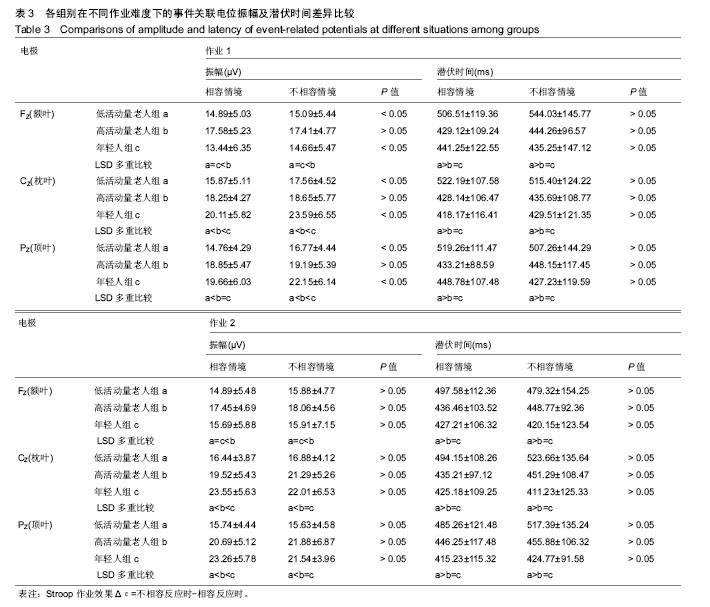
| [1] Fotenos AF, Snyder AZ, Girton LE, et al. R. L. Normative estimates of cross-sectional and longitudinal brain volume decline in aging and AD. Neurology.2005;64:1032-1039. [2] Irene Forcada, Maria Mur, Ester Mora, et al. The influence of cognitive reserve on psychosocial and neuropsychologicalfunctioning in bipolar disorder. Eur Neuropsychopharmacol. 2015;25(2):214-222.[3] Dustman RE, Emmerson RY, Shearer DE, et al. Physical activity, age and cognitive-neuropsychological function. J Aging Phys Act . 1994;2: 143-181.[4] Erickson KI, Hillman CH, Kramer AF, et al. Physical activity, brain, and cognition. Current Opinion in Behavioral Sciences, 2015;4: 27-32. [5] 王骏濠,蔡佳良.运动或身体活动介入对认知控制功能的影响[J].中华体育季刊,2010,24(4):70-81.[6] Douglas PK, Gutman B, Anderson A, et al. Hemispheric brain asymmetry differences in youths with attention-deficit hyperactivity disorder. Neuroimage Clin. 2018;18:744-752.[7] Davis SW, Dennis NA, Daselaar SM, et al. The posterior anterior shift in aging. Cerebral Cortex.2007;18: 1201-1209. [8] Lorenzo-López L, Amenedo E, Pascual-Marqui RD, et al. F. Neural correlates of age-related visual search decline: A combined ERP and sLORETA study. Neuroimage.2008;41: 511-524. [9] Li L, Gratton C, Fabiani M, et al. Age-related frontoparietal changes during the control of bottom-up and top-down attention: an ERP study. Neurobiol Aging. 2013;34(2):477-488. [10] 张育恺,吴聪义.急性健身运动对认知功能的影响事件相关电位的文献回顾[J].体育学报,2011;4(1):1-28.[11] Hillman CH, Kamijo K, Scudder MA, et al. review of chronic and acute physical activity participation on neuroelectric measures of brain health and cognition during childhood. Prev Med. 2011;52 Suppl 1:S21-S28. [12] Iso-Markku P, Waller K, Vuoksimaa E, et al. Objectively measured physicalactivity profile and cognition in Finnish elderly twins. Alzheimers Dement (N Y). 2018;4:263-271.[13] Polich J. Updating P300: An integrative theory of P3a and P3b. Clin Neurophysiol. 2007;118(10):2128-2148. [14] Miyake A, Friedman NP, Emerson MJ, et al. The unity and diversity of executive functions and their contributions to complex “frontal lobe” tasks: A latent variable analysis. Cogn Psychol. 2000; 41(1):49-100. [15] Colcombe S, Kramer AF. Fitness effects on the cognitive function of older adults a meta-analytic study. Psychol Sci. 2003;14(2): 125-130. [16] Prakash RS, Voss MW, Erickson KI, et al. Physical activity and cognitive vitality. Annu Rev Psychol. 2015;66:769-797[17] Nee DE, Wager TD, Jonides J, et al. Interference resolution: Insights from a meta-analysis of neuroimaging tasks. Cogn Affect Behav Neurosci. 2007;7(1):1-17. [18] Raquel Monteiro, Marco Simões, João Andrade, et al. Processing of Facial Expressions in Autism: a Systematic Review of EEG/ERP Evidence. Rev J Autism Dev Disord. 2017;4:255-276.[19] Van Boxtel MP, Langerak K, Houx PJ, et al. Self-reported physical activity, subjective health, and cognitive performance in older adults. Exp Aging Res. 1996;22(4):363-379. [20] Reid-Arndt SA, Matsuda S, Cox CR. Tai Chi effects on neuropsychological, emotional, and physical functioning following cancer treatment: A pilot study. Complement Ther Clin Pract. 2012; 18(1):26-30.[21] Gajewski PD, Falkenstein M. Long-term habitual physical activity is associated with lower distractibility in a Stroop interference task in aging: Behavioral and ERP evidence. Brain Cogn. 2015;98: 87-101. [22] Pontifex MB, Hillman CH, Polich J. Age, physical fitness, and attention: P3a and P3b. Psychophysiology.2009;46: 379-387. [23] 郭世杰,赖韵如,杨子孟.中年及老年人不同休闲时间身体活动量效关系与中风发生率之关联[J].大专体育学刊, 2014,16(3):342-352.[24] 陈心怡,花茂棽,朱建军,等.以魏氏成人智力量表第三版四因素为基础的简短式测验组型[J].中华心理学刊,2008;50(1):91-109.[25] Kray J, Eppinger B, Mecklinger A. Age differences in attentional control: An event-related potential approach. Psychophysiology. 2005;42:407-416.[26] West R, Alain C. Age-related decline in inhibitory control contributes to the increased Stroop effect observed in older adults. Psychophysiology.2000; 37: 179-189. [27] Etnier JL, Chang YK. The effect of physical activity on executive function: A brief commentary on definitions, measurement issues, and the current state of the literature. J Sport Exerc Psychol. 2009; 31(4):469-483. [28] Salthouse TA. The processing-speed theory of adult age difference in cognitive. Psychology Reviewed.1996;103: 403-428. [29] Salthouse TA, Atkinson TM, Bersih DE. Executive function as a potential mediator of age-related cognitive decline in normal adults. J Exp Psychol Gen. 2003;132(4):566-594. [30] Mager R, Bullinger AH, Brand S, et al. Age-related changes in cognitive conflict processing: An event-related potential study. Neurobiol Aging. 2007;28(12):1925-1935. [31] Bérengère Staub, Nadège Doignon-Camus, José Eduardo Marques-Carneiro, et al. Age-related differences in the use of automatic and controlled processes in a situation of sustained attention. Neuropsychologia. 2015;75:607-616.[32] Cid-Fernández S, Lindín M, Díaz F. Information processing becomes slower and predominantly serial in aging: Characterization of response-related brain potentials in an auditory–visual distraction–attention task. Biol Psychol. 2016 Jan;113:12- 23.[33] Hillman CH, Kramer AF, Belopolsky AV, et al. A cross-sectional examination of age and physical activity on performance and event-related brain potentials in a task switching paradigm. Int J Psychophysiol. 2006;59(1):30-39. [34] Chang YK, Huang CJ, Chen KF, et al. Physical activity and working memory in healthy older adults: An ERP study. Psychophysiology. 2013;50(11):1174-1182.[35] Maillet D, Rajah MN. Age-related changes in the three-way correlation between anterior hippocampus volume, whole-brain patterns of encoding activity and subsequent context retrieval. Brain Res. 2011;1420:68-79.[36] Kang L, Zhao W, Zhang G, et al. Acetylated 8-oxoguanine DNA glycosylase 1 and its relationship with p300 and SIRT1 in lens epithelium cells from age-related cataract. Exp Eye Res. 2015; 135:102-108.中国组织工程研究杂志出版内容重点:组织构建;骨细胞;软骨细胞;细胞培养;成纤维细胞;血管内皮细胞;骨质疏松;组织工程 |
| [1] | Zhang Tongtong, Wang Zhonghua, Wen Jie, Song Yuxin, Liu Lin. Application of three-dimensional printing model in surgical resection and reconstruction of cervical tumor [J]. Chinese Journal of Tissue Engineering Research, 2021, 25(9): 1335-1339. |
| [2] | Zeng Yanhua, Hao Yanlei. In vitro culture and purification of Schwann cells: a systematic review [J]. Chinese Journal of Tissue Engineering Research, 2021, 25(7): 1135-1141. |
| [3] | Xu Dongzi, Zhang Ting, Ouyang Zhaolian. The global competitive situation of cardiac tissue engineering based on patent analysis [J]. Chinese Journal of Tissue Engineering Research, 2021, 25(5): 807-812. |
| [4] | Zhao Xiang, Wei Cuilan, Zhang Yeting. Neurogenesis and neuroinflammation under exercise: alteration and regulation [J]. Chinese Journal of Tissue Engineering Research, 2021, 25(5): 813-820. |
| [5] | Wu Zijian, Hu Zhaoduan, Xie Youqiong, Wang Feng, Li Jia, Li Bocun, Cai Guowei, Peng Rui. Three-dimensional printing technology and bone tissue engineering research: literature metrology and visual analysis of research hotspots [J]. Chinese Journal of Tissue Engineering Research, 2021, 25(4): 564-569. |
| [6] | Chang Wenliao, Zhao Jie, Sun Xiaoliang, Wang Kun, Wu Guofeng, Zhou Jian, Li Shuxiang, Sun Han. Material selection, theoretical design and biomimetic function of artificial periosteum [J]. Chinese Journal of Tissue Engineering Research, 2021, 25(4): 600-606. |
| [7] | Liu Fei, Cui Yutao, Liu He. Advantages and problems of local antibiotic delivery system in the treatment of osteomyelitis [J]. Chinese Journal of Tissue Engineering Research, 2021, 25(4): 614-620. |
| [8] | Li Xiaozhuang, Duan Hao, Wang Weizhou, Tang Zhihong, Wang Yanghao, He Fei. Application of bone tissue engineering materials in the treatment of bone defect diseases in vivo [J]. Chinese Journal of Tissue Engineering Research, 2021, 25(4): 626-631. |
| [9] | Zhang Zhenkun, Li Zhe, Li Ya, Wang Yingying, Wang Yaping, Zhou Xinkui, Ma Shanshan, Guan Fangxia. Application of alginate based hydrogels/dressings in wound healing: sustained, dynamic and sequential release [J]. Chinese Journal of Tissue Engineering Research, 2021, 25(4): 638-643. |
| [10] | Chen Jiana, Qiu Yanling, Nie Minhai, Liu Xuqian. Tissue engineering scaffolds in repairing oral and maxillofacial soft tissue defects [J]. Chinese Journal of Tissue Engineering Research, 2021, 25(4): 644-650. |
| [11] | Li Jun, Zuo Xinhui, Liu Xiaoyuan, Zhang Kai, Han Xiangzhen, He Huiyu, . Effect of over expression of miR-378a on osteogenic and vascular differentiation of bone marrow mesenchymal stem cell sheet [J]. Chinese Journal of Tissue Engineering Research, 2021, 25(31): 4939-4944. |
| [12] | Xing Hao, Zhang Yonghong, Wang Dong. Advantages and disadvantages of repairing large-segment bone defect [J]. Chinese Journal of Tissue Engineering Research, 2021, 25(3): 426-430. |
| [13] | Fan Jin, Zeng Luyao, Zhong Dongling, Li Yuxi, Tian Yanping, Huang Yijie, Jin Rongjiang. Development of functional near-infrared spectroscopy in recent 10 years: a visual analysis using CiteSpace [J]. Chinese Journal of Tissue Engineering Research, 2021, 25(23): 3711-3717. |
| [14] | Chen Siqi, Xian Debin, Xu Rongsheng, Qin Zhongjie, Zhang Lei, Xia Delin. Effects of bone marrow mesenchymal stem cells and human umbilical vein endothelial cells combined with hydroxyapatite-tricalcium phosphate scaffolds on early angiogenesis in skull defect repair in rats [J]. Chinese Journal of Tissue Engineering Research, 2021, 25(22): 3458-3465. |
| [15] | Wang Hao, Chen Mingxue, Li Junkang, Luo Xujiang, Peng Liqing, Li Huo, Huang Bo, Tian Guangzhao, Liu Shuyun, Sui Xiang, Huang Jingxiang, Guo Quanyi, Lu Xiaobo. Decellularized porcine skin matrix for tissue-engineered meniscus scaffold [J]. Chinese Journal of Tissue Engineering Research, 2021, 25(22): 3473-3478. |
| Viewed | ||||||
|
Full text |
|
|||||
|
Abstract |
|
|||||
